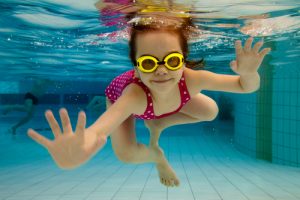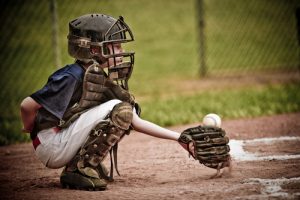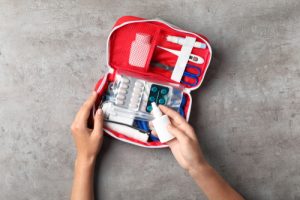According to the American Academy of Ophthalmology, thousands of people are hurt by sports-related eye injuries each year. About 13,500 of these injuries result in permanent vision loss.
One in three eye injuries involves children. These alarming numbers have been rising over the last decade.
The staff at Minnesota Eye Consultants wants to remind athletes and casual sports players that most sports-related eye injuries can be avoided by wearing the proper protection.
Serious injuries, which most commonly occurred during water sports and basketball, included infections, corneal abrasions, eye socket fractures, swollen or detached retinas, and traumatic cataracts.
Baseball, hockey, and martial arts are also considered high-risk sports. Fast flying balls, hockey pucks and sticks, and elbows cause many injuries.
This is especially common among children and teenagers. Some sports are more dangerous than others. There is some risk involved in nearly all athletic activities.
Because of the COVID-19 pandemic, sports teams are not meeting right now, but children are still playing sports in their homes and with their parents during the quarantine. This makes eye protection just as important as ever!
Glasses and Contacts Are Not Enough!

Glasses and contacts do not provide eye protection from impact or damage. In fact, some glasses can shatter, and make an eye injury much worse.
Protective eyewear should be made from polycarbonate material. Polycarbonate material resists shattering and can provide UV (ultraviolet light) protection. Polycarbonate lenses are superior to plastic because they are thinner, lighter, and more impact resistant.
Some Tips When Buying Protective Eyewear:
- Make sure that you buy the right level of protective eyewear for yourself and your family.
- Consult your Minnesota Eye Consultants doctor to get advice on the best eye protection for your sport and lifestyle.
- If you wear prescription glasses, ask your eye doctor to fit you for prescription eye protection.
- Sports eye protection should have padding or cushion along the brow and bridge of the nose. Padding will prevent the eye guards from cutting the skin.
- Try on eye protection to determine if it is the right size. Adjust the strap and make sure it is not too tight or too loose.
- Look for eye guards that have an anti-fogging coating, which can be very helpful when playing sports in the heat and humidity outdoors.
- Buy eye guards at optical shops or sports specialty stores and ask for a staff member who is knowledgeable about protective eyewear.
You May Need More Protection for Your Sport

In many sports, polycarbonate glasses or goggles are not enough. An organization called ASTM sets international standards for equipment needed to prevent eye injuries.
These standards are very specific to each type of sport. Most sports organizations have specific recommendations for injury protection. For example, there may be specific goggles that are best for racket sports or lacrosse.
Some examples of extra protection needed are:
- Helmets with eye and face protectors for ice hockey
- Faceguards mounted to the helmet for youth baseball
- Special high impact goggles for Alpine skiing
We recommend that you consult the ASTM website to find the most current and appropriate ASTM standards for the sport you or your children are playing. Look for the appropriate ASTM standard for your sport on the product and/or its packaging before making a purchase!
Don’t Forget UV Protection!

Even though you can’t see the sun’s rays, it doesn’t mean your eyes aren’t being damaged by them. Your eyes can suffer serious damage due to exposure to the sun’s ultraviolet rays.
This can happen during all outdoor sports and recreation activities. Whether you are skiing in the winter or water skiing in the summer, you are susceptible to sunburn and glare.
Be sure to wear protective eyewear with UV protection for all your outdoor activities even if it’s cloudy outside.
First Aid for Eye Injuries

The organization Prevent Blindness has some excellent information on first aid that we have included below.
It’s always good to be prepared for an injury. Stock a first aid kit with a rigid eye shield and some commercial eyewash. Familiarize yourself with the basic first aid tips that are explained below.
Do not assume that any eye injury is minor. If you have any doubt, see an eye doctor right away.
Specks in the Eye:
- Do not rub the eye!
- Try to wash out the speck with tears or a commercial eyewash if available.
- Never use tweezers or any item to try to remove the speck as this can cause further damage to the eye.
- If the speck doesn’t wash out, see an eye doctor immediately.
Blows or Trauma to the Eye:
- Apply a cold compress to the eye without using pressure. Using a clean damp washcloth is fine.
- Call your eye doctor or go to a hospital for emergency medical care in cases of pain, blurry vision, eye swelling, blood inside the eye, or discoloration (black eye). These symptoms could mean there is internal eye damage.
Cuts and Punctures to the Eye or Eyelid:
- Do not attempt to remove any foreign object.
- Do not rinse the eye with any liquid, including water.
- Cover the eye with a protective shield if you have one. If not, you can make one with the bottom half of a paper cup. Secure the shield or cup to the brow above the eye and the cheekbone below the eye. Do not apply pressure.
- Seek emergency care as soon as possible.
Remember that whenever you play sports of any kind, you should also wear the proper eye protection as well. This is the best way to ensure that your eyes will be safe when you play sports and will help you avoid the possibility of suffering permanent vision loss.
Concerned that you may have experienced a sports-related eye injury? Contact Minnesota Eye Consultants in Minneapolis, MN to schedule a virtual teleophthalmology visit for non-urgent appointments!









